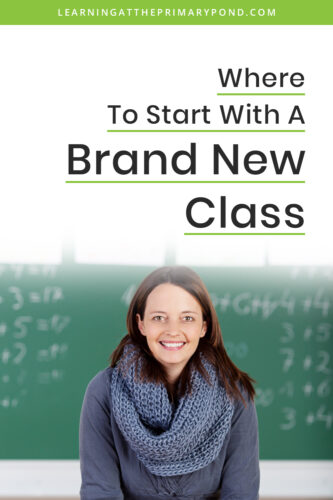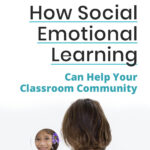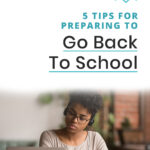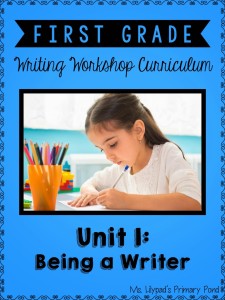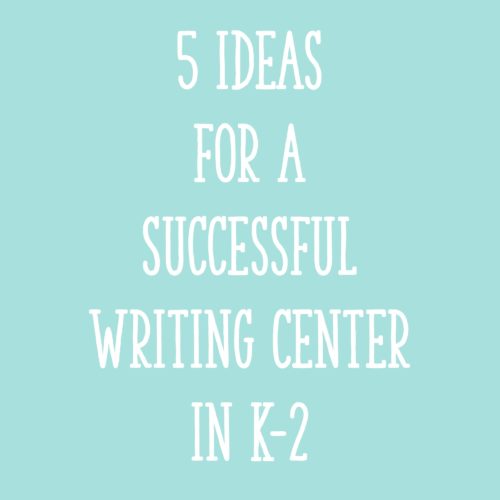When you begin the school year with a new class, it can feel like “system overload!” There’s the physical organization of the room (desk set-up, teacher’s desk, student materials, etc.). Then, you have to plan your systems and routines for students, AND practice, practice, practice with them!
Of course, building classroom community is key at the beginning of the year, too. You want to get to know each student – their likes/dislikes, what makes them tick as individuals.
And on top of ALL of this… you want to know their academic strengths and areas of growth!
There’s so much to do and so little time. So how do you fit it all in or choose what to prioritize?
I have a video (and transcript, if you prefer to read) that will help walk you through where to start with a brand new class, particularly when it comes to gathering data.
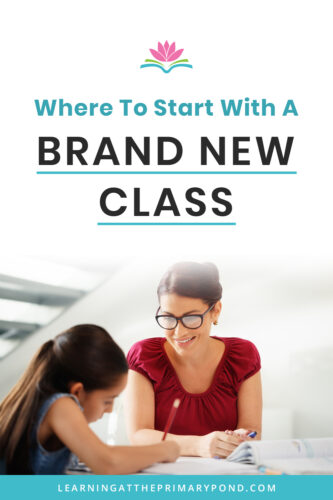
Watch the video to find out what tips I have to offer!
Transcript:
“Hey, I’m Alison, I’m a literacy specialist from Learning at the Primary Pond and in this video, I’m going to share some really practical tips with you for where to get started with a brand new class in terms of figuring out what their needs are and what their strengths are as well. If you haven’t subscribed to my channel (https://www.youtube.com/@learningattheprimarypond) yet, make sure to do that now and then also hit the little bell so that you don’t miss any of the brand new videos that I post about teaching literacy in K-2.
Before I talk about anything else, I’m going to share one really important thing with you. It is very easy to get overwhelmed by, or even just not make the most of data when you have a lot of it and a whole class of students to deal with. The number one most helpful thing that I found is before you look at any data, before you know what you already got, before you figure out what kind of data you’re going to try to get through assessments; make a list of what you want to know most about your students, at least as it comes to their academics.
Now this will vary by grade level. In kindergarten, it could be can they write their name, how many letters can they identify, what’s their phonological awareness skill level like (that could be like could they rhyme) can they identify the first sound in a word, can they blend sounds? You don’t have to get all of the data at the beginning of the year. Even just their print skills – can they track print left to right?
For first and second grade, what phonics patterns do they already know? Is there a certain level of book that they are proficient with reading – if you use some kind of leveling system? What is their spelling like? List out what you want to know about your kids and when you’re trying to figure out what you want to know, think about your whole literacy block. Think about what will you be teaching, what kind of independent activities will the kids be doing, and how will you make small groups? You want to really envision what your classroom is going to look like when it’s up and running and then think backwards as far as what do I need to know about my kids in order to plan the best instruction for whole group, small group, and then even just independent activities.
Let me back up a little bit. The reason why this is so valuable is because it gives you a lens that you can use to focus on the data and also make decisions if you’re going to be deciding what you’ll be assessing. So that is really helpful, I strongly encourage you to do that first. Then you can start going over data and figuring out what assessments you want to do to and really figure out what their strengths are, and also what their needs are if you teach pretty much anything other than kindergarten. Maybe if you teach kindergarten, you have preschool data, but you’re probably going to have some data from a previous year about your students. This can be helpful, but I like to glance at it as a starting point. I rake the assessment data that I get right in front of me that very school year because we don’t know what happened over the summer. There may have been a weird situation with the assessment last year, you just don’t know. So I like to look at that data and I find it helpful, but I also take it with a grain of salt and I want to get updated data.
Speaking of getting updated data, one thing that was really helpful to me when I taught kindergarten, a couple of days before school began, I would bring families one at a time to my classroom. This was just like a school-wide, maybe even a district-wide thing, and I would give them a little assessment and the parents would fill out some paperwork and they’d get to see their classroom and that was incredibly helpful. If you’ve ever taught kindergarten, then you know that the beginning of the school year is a little hectic. It can be hard to work one-on-one with the kiddos because the other kids aren’t very independent, so those pre beginning of the year little meetings for assessment were incredibly, incredibly helpful. I really think with any grade level, if you can pull that off. Maybe talk to your school about it, it can make a big difference.
Another option too is if your school has pre-set assessment days where you’re supposed to be giving assessments these days. Maybe even you get a sub for part of the day or some kind of assistance. So I’m curious, I know schools all do it differently, in the comments, let me know if your school has pre beginning of the school year days or dedicated assessment days so that you can get that data. Hopefully you have some type of support in getting it because especially at the K-2 level, it’s not always easy to get the other kids to work independently for any length of time so that you can really get that data. So fingers crossed that you have some dedicated days or support to get that, and now if you don’t have those days, it is absolutely still doable to assess. I have done it in different ways. One thing that I’ve done is toward the end of the day, I would come up with some sort of activity. For second graders, they were copying over the high frequency words that they learned in first grade into their little word notebooks – that was something all the kids could work on and I can pull kids.
I was kind of doing it in small chunks, but I also feel like if you can set aside a whole half a day, that can be more efficient too because you get into a groove, you’re pulling kids, but if you are going to set aside a whole half day, then you need like some sort of aide or sub or coverage, right? Because the kids are not going to be able to work independently for half a day. So you have to weigh out what you have but if you don’t have support, just do it in small chunks like I mentioned.
There may be things that are nice to know or you would like to know, but you don’t have to know immediately. So there are certain things like with kindergartners, I was talking about the print skills. At the beginning of the year, I want to know can they write their names, like some basic stuff. Then, later on, before we’re maybe going to go into small groups, I do want to see what their print skills are, can they track left to right, do they know some of those basic skills, but I don’t need that data immediately. So you might take that list that you made and prioritize, I want this at the very beginning of the year, or I can wait on some of this. Because it can be a lot, right? We’ve talked about how kids, especially kinders, but really any primary grade, it’s hard to get them to work independently. So prioritize, prioritize.
One thing that I find really helpful, and I actually have this resource for free, I’ll include a link to it with this video, especially for first and second grade, is a phonics diagnostic assessment. If you’ve watched other videos, you may have heard me talk about this before, but it is a simple assessment that’s not time-consuming. There is one piece that would be done one-on-one but the other piece can be done in small group or a whole group, and you get to figure out what types of phonics patterns kids can read and also what they can spell. This data is so valuable because it will help you with small groups. It will help you with where to even start in your phonics scope and sequence. It will reveal detailed data such as “Okay, all of these kids are struggling with blends or all of these kids are proficient in vowel teams.”
There’s an individual student page where you can write all the data for one student on it but then there’s also class pages. Again this is good because it will help you number one figure out where to start in your phonics curriculum as a whole. Do you need to go back and review other concepts or can you go ahead? You’ll see if you use the class sheet, you’ll see groups of kids that stand out to you. “Oh, these students are struggling with this skill or they’re good with this skill.” So small group assessment, and then you may also be able to identify outliers. Like if one kiddo is really behind on their phonics skills but the rest of the kids are like over here, then you may just know, “Hey, I’m going to have to work a little bit one-on-one with this student or get the student some help from a teaching assistant or get them intervention or whatever.” It will help you identify what to work on whole group, small group, but also with any outliers who may be really behind or really far ahead.I’m going to include the link or this along with this video so you can grab it. Again, like I said at the very beginning, if you need to figure out where your kids are before you dive into all that data, make a list of what you most need to know and then also prioritize because it doesn’t all have to be assessed at the very beginning of the school year. So I hope that tip and everything else was helpful. Of course, let me know if you have any questions. Thanks so much for watching, don’t forget to hit the like button to subscribe (https://www.youtube.com/@learningattheprimarypond), and I will see you in the next video.”
Conclusion
I’m hoping that after reading (or watching!) this blog, you feel a bit more at ease – and maybe even excited to welcome a brand new class!
If you’re looking for a FREE phonics assessment, look no further! In this diagnostic assessment, you’ll be able to quickly pinpoint skills that students need the most work on. Learn how this free phonics assessment will help you and your Kindergarten, 1st, or 2nd grade students here: Free Phonics Diagnostic Assessment

Happy teaching!
